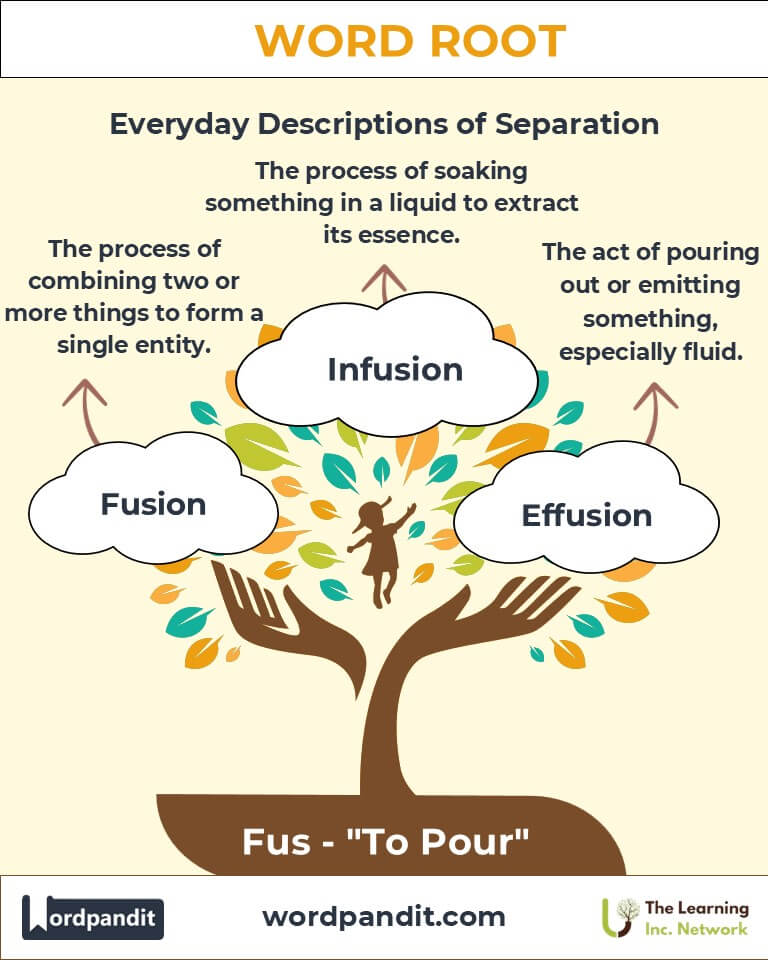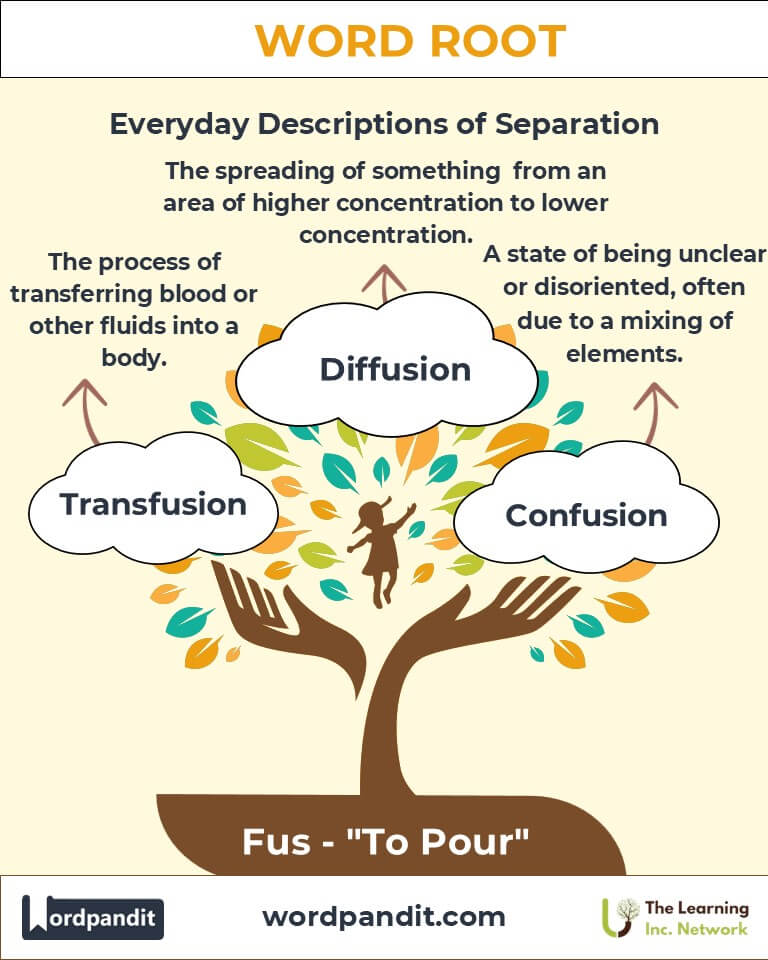Fus: The Root of Fusion and Connection Across Disciplines
Discover the richness of the word root "Fus," stemming from the Latin fundere meaning "to pour" or "to melt." Words derived from this root, such as "fusion" and "infuse," reveal its essence: the act of joining, blending, or flowing together. This root is a linguistic cornerstone for expressions of combination and transformation in both everyday language and specialized fields.

Table of Contents
- Introduction: The Flowing Essence of Fus
- Etymology and Historical Journey
- Mnemonic: Unlocking the Power of Fus
- Common Fus-Related Terms
- Fus Through Time
- Fus in Specialized Fields
- Illustrative Story: Fus in Action
- Cultural Significance of the Fus Root
- The Fus Family Tree
- FAQs about the Fus Word Root
- Test Your Knowledge: Fus Mastery Quiz
- Conclusion: The Living Legacy of Fus
1. Introduction: The Flowing Essence of Fus
Picture molten metal being poured into a mold to create a sculpture—that’s the power of the root "Fus." Pronounced as "fyooz," it encapsulates the ideas of pouring, merging, and transforming. Derived from Latin, "Fus" manifests in words across science, art, and language, symbolizing the interconnectedness of elements.

2. Etymology and Historical Journey
The root "Fus" originates from the Latin fundere, meaning "to pour" or "to melt." During the Roman era, this term was often used in metallurgy and sculpture. As Latin evolved into Romance languages, the root "Fus" entered English, enriching vocabulary with words that symbolize blending and transformation, such as "infuse" and "diffuse."
3. Mnemonic: Unlocking the Power of Fus
Imagine a fountain pouring water continuously, symbolizing the act of flow and combination.
Mnemonic Device: Fus flows into fusion, diffusion, and infusion—melding all into one.
4. Common Fus-Related Terms
- Fusion (fyoo-zhun): The act of merging different entities into one.
Example: "The chef’s fusion cuisine blended flavors from Asia and Europe." - Infuse (in-fyooz): To introduce or instill qualities into something.
Example: "The tea was infused with mint for a refreshing taste." - Diffuse (di-fyooz): To spread out or scatter.
Example: "The lamp’s shade diffused the light, creating a soft glow." - Effuse (ef-fyooz): To pour out or emit.
Example: "The volcano effused lava across the landscape." - Transfuse (trans-fyooz): To transfer or instill, often used medically.
Example: "Blood transfusions save countless lives daily."
5. Fus Through Time
- Profuse (Historical): Initially denoting lavish abundance, the term retains its sense of overflow today.
Example: "The profuse decorations at the festival overwhelmed the senses." - Confusion (Evolving): Rooted in the idea of mixing or disorder, "confusion" has shifted from describing physical mixing to mental disarray.
Example: "The instructions caused confusion among the participants."
6. Fus in Specialized Fields
- Physics and Chemistry:
Nuclear Fusion: The process of combining atomic nuclei to release energy.
Application: Central to research in sustainable energy. - Medicine:
Transfusion: The transfer of blood or fluids to treat patients.
Importance: Lifesaving in emergency care and surgeries. - Art and Music:
Fusion Genres: Combining styles from different traditions.
Example: "Jazz fusion blends jazz with rock or funk." - Environmental Science:
Diffusion: The natural spreading of substances in air or water.
Relevance: Crucial in understanding ecosystems and pollutant behavior.
7. Illustrative Story: Fus in Action
Dr. Elena Russo, a researcher, worked on developing fusion energy as a sustainable power source. Inspired by the fusion of artistic ideas in her hometown’s music festival, she realized that collaboration was key. By infusing her team with interdisciplinary insights, she accelerated their breakthroughs. Her journey exemplified the transformative power of Fus: merging diverse elements to create something groundbreaking.
8. Cultural Significance of the Fus Root
From ancient metallurgical practices to modern fusion cuisine, the Fus root captures humanity’s drive to connect and transform. Its influence is evident in art, science, and even philosophy, symbolizing unity and innovation across cultures.

9. The Fus Family Tree
Related Roots:
- Fund- (Base, pour):
Foundation: The basis or groundwork.
Refund: To pour back or repay. - Found- (Establish):
Founder: One who establishes.
Confound: To perplex by mixing ideas. - Fluid- (Flow):
Influence: The power to shape ideas, akin to flowing into minds.

FAQs About the Fus Word Root
Q: What does "Fus" mean?
A: Fus comes from the Latin fundere, meaning "to pour" or "to melt." It is often associated with combining or blending elements, as seen in words like "fusion" and "infusion."
Q: How is "diffuse" related to "Fus"?
A: The term "diffuse" originates from dis- (apart) and fundere (to pour), literally meaning "to pour out." It now signifies the spreading or scattering of substances, such as light, gas, or ideas.
Q: What is the difference between fusion and fission?
A: Fusion involves merging two or more elements to create one, such as nuclear fusion in stars. Fission, in contrast, refers to splitting one entity into smaller parts, such as the splitting of atomic nuclei in nuclear fission.
Q: Can "infusion" apply to non-liquid concepts?
A: Yes, "infusion" can also mean introducing qualities, ideas, or energy into something. For example, a leader might infuse a team with enthusiasm.
Q: What does "effusion" mean in medical and non-medical contexts?
A: In medical terms, "effusion" describes the leakage of fluid into a body cavity, such as pleural effusion in the lungs. Outside medicine, it refers to an outpouring of feelings or words, like an effusion of gratitude.
Q: How does "confusion" relate to the Fus root?
A: "Confusion" combines con- (together) and fundere (to pour), originally meaning "to mix together." Its modern sense of disorder or misunderstanding stems from this imagery of a chaotic blending.
Q: What are real-world examples of "fusion"?
A: Fusion is seen in fields like culinary arts (fusion cuisine), energy (nuclear fusion), and art/music (fusion genres blending different styles).
Q: Why is "transfuse" significant in medicine?
A: "Transfuse" refers to transferring fluids, such as blood, into a patient. It is critical in saving lives during surgeries, trauma care, and treatment of conditions like anemia.
Test Your Knowledge: Fus Word Root Quiz
1. What does the root "Fus" mean?
2. What does "diffusion" mean?
3. Which word describes the process of combining atomic nuclei to release energy?
4. What does "transfuse" primarily mean?
5. In art, what does "fusion" commonly refer to?
12. Conclusion: The Living Legacy of Fus
The root "Fus" symbolizes the beauty of unity and transformation, threading through languages and disciplines. Whether in physics, art, or everyday interactions, it highlights the power of flow and connection. As technology advances and ideas converge, the legacy of Fus continues to inspire innovation and creativity in shaping the world around us.













Thanks for your effort to enlighten us…
Thank you very much i want to learn more words to understand the meanings.
Superb…
I can learn many words in less time
Really a effective technique.
Its really an effective technique not a effective